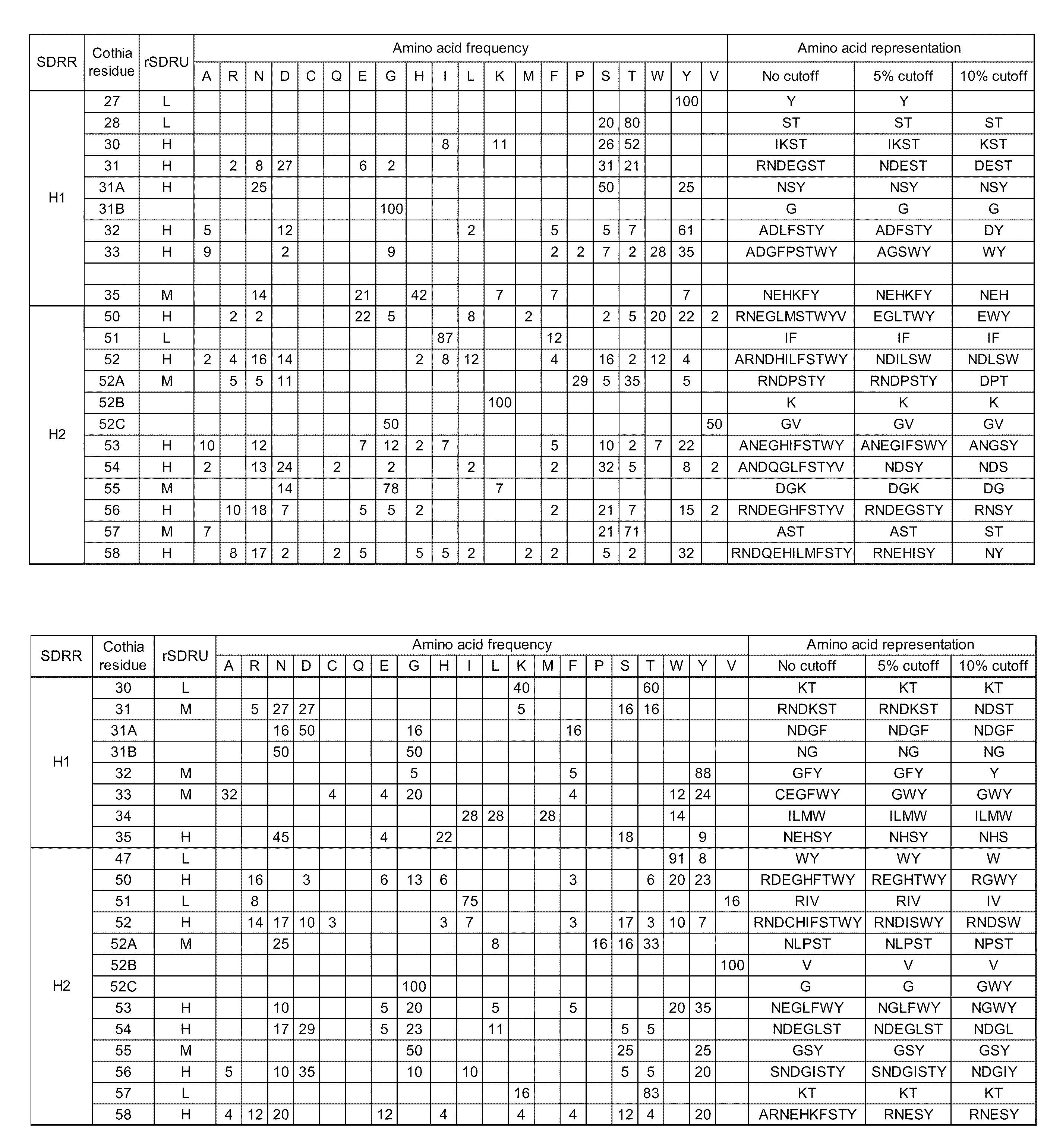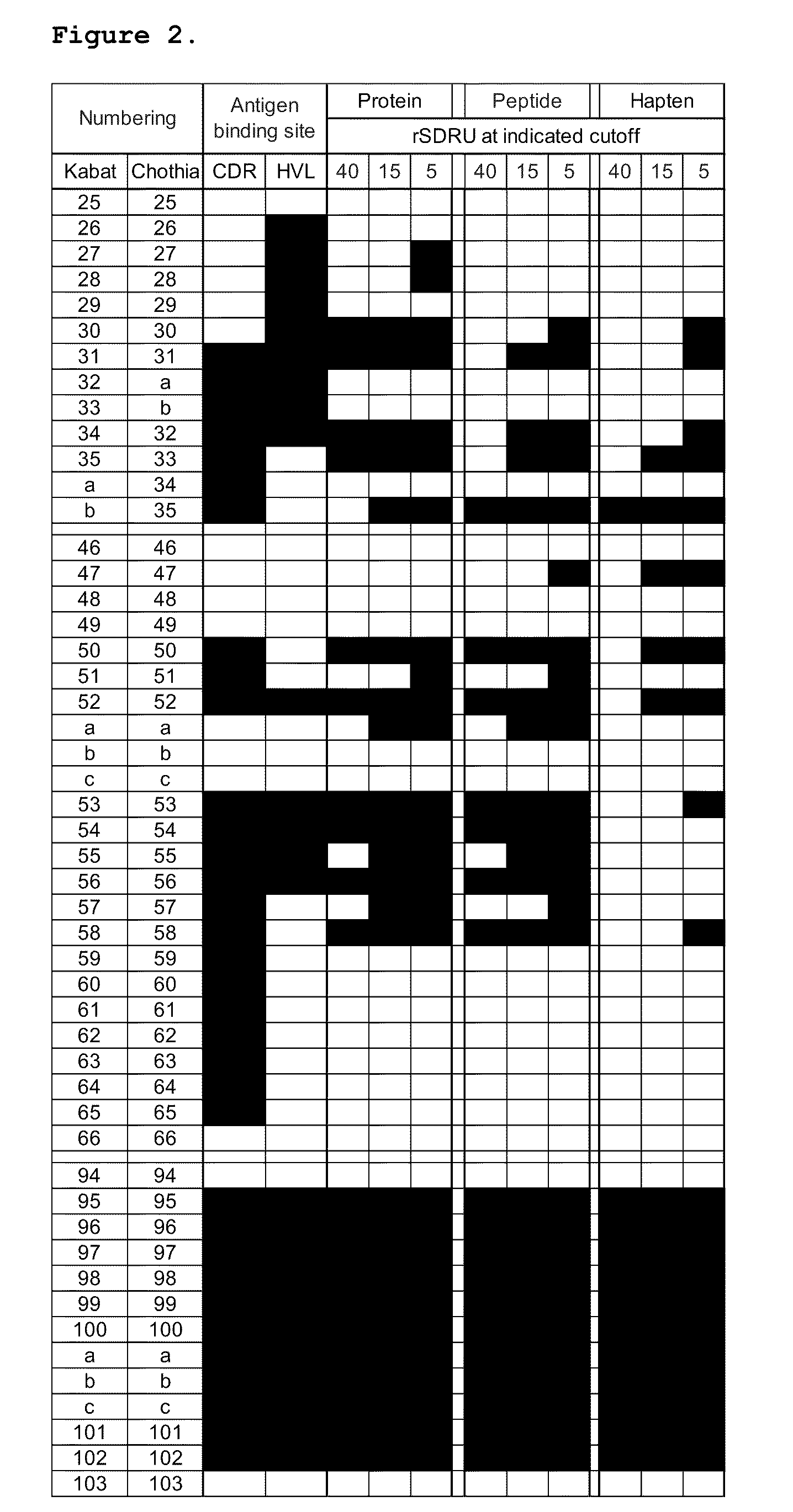Methods of Affinity Maturing Antibodies
a technology of affinity maturation and antibodies, applied in the direction of immunoglobulins, peptides, directed macromolecular evolution, etc., can solve the problems of increasing exponentially, limited number of residues that can be diversified, and increasing immunogenicity and production costs, so as to improve affinity
- Summary
- Abstract
- Description
- Claims
- Application Information
AI Technical Summary
Benefits of technology
Problems solved by technology
Method used
Image
Examples
example 1
Determining rSDRUs
[0087]rSDRUs were identified by analyzing antigen-antibody complexes available at IMGT (http: / / imgt cines fr), in a manner similar to previously described for a smaller set of complex structures (Almargo, J Mol Recognit. 17:132-43, 2004.). A total of 933 structures were compiled in the database in Mar. 23, 2008. Out of these, 478 entries contained antibodies in complex with proteins, peptides or haptens. The 478 structures were further filtered using the following criteria: (1) structures solved at 3.0 Å resolution or below, (2) V kappa antibodies, (3) human or mouse antibodies, and (4) unique antibodies as judged by the antibody name and sequence comparisons. After this filtering step, the resulting 142 structures included 67 antibodies in complex with proteins, 28 in complex with peptides, and 47 in complex with haptens. The dataset consisted of 91% mouse and 9% human antibodies which are summarized in FIG. 3.
[0088]FIGS. 4 and 5 show V kappa and VH sequences of a...
example 2
Calculating Specificity Determining Residue Matrices “SDRM”
[0090]Amino acid distributions at each V kappa or VH rSDRUs were defined and are presented in the form of SDRMs (Specificity Determining Residue Matrices). SDRM represents the contribution of each of the 20 amino acids at each rSDRU residue (FIGS. 8 and 9). Overall, anti-protein antibodies exhibited the highest diversity in amino acid residues in the SDRMs. Anti-hapten antibodies utilized a more restricted set of amino acids to recognize the antigens.
V Kappa SDRM
[0091]Differences in the distribution of amino acid types were noted among SDRR regions and across the types of antigens in V kappa (FIG. 7). Across all antigen types, Arg, Asn, Asp, His, Ser, Thr and Tyr occur most frequently in contact sites. Cys, Pro, Gln, Glu, and hydrophobic amino acids such as Ala,
[0092]Ile, Leu, Met, Phe, and Val occur less frequently. Thus, hydrophilic amino acids predominate over hydrophobic residues. Comparing different SDRR regions, Asn an...
example 3
Affinity-Maturation of Anti-Oncostatin M Antibodies
[0098]Oncostatin M (OSM) (GenBank Accession No. NP—065391) is a multifunctional member of the IL-6 family of cytokines secreted by monocytes, macrophages, neutrophils and activated T-lymphocytes (Tanaka & Miyajima, Rev Physiol Biochem Pharmacol, 149:39-53, 2003), and functions in oncogenic processes and inflammatory and hypertrophic pathways leading to deleterious conditions such as pulmonary fibrosis.
[0099]De novo Fab-pIX libraries (Shi et al., J Mol Biol, 397:385-96, 2010; WO2009 / 085462; U.S. Ser. No. 12 / 546850) were panned using biotinylated human OSM (R&D Systems, amino acids 26-221 of NP—065391) captured on paramagnetic Streptavidin beads (Invitrogen, Carlsbad, Calif.) following a published protocol for phage selection (Marks and Bradbury, Antibody Engineering, Vol. 248: 161-176, Humana Press, 2004). The libraries were generated by diversifying human germline IGVH genes IGHV1-69*01, IGHV3-23*01, and IGHV5-51*01, and human germl...
PUM
| Property | Measurement | Unit |
|---|---|---|
| affinity | aaaaa | aaaaa |
| solubility | aaaaa | aaaaa |
| stability | aaaaa | aaaaa |
Abstract
Description
Claims
Application Information
 Login to View More
Login to View More - R&D
- Intellectual Property
- Life Sciences
- Materials
- Tech Scout
- Unparalleled Data Quality
- Higher Quality Content
- 60% Fewer Hallucinations
Browse by: Latest US Patents, China's latest patents, Technical Efficacy Thesaurus, Application Domain, Technology Topic, Popular Technical Reports.
© 2025 PatSnap. All rights reserved.Legal|Privacy policy|Modern Slavery Act Transparency Statement|Sitemap|About US| Contact US: help@patsnap.com



